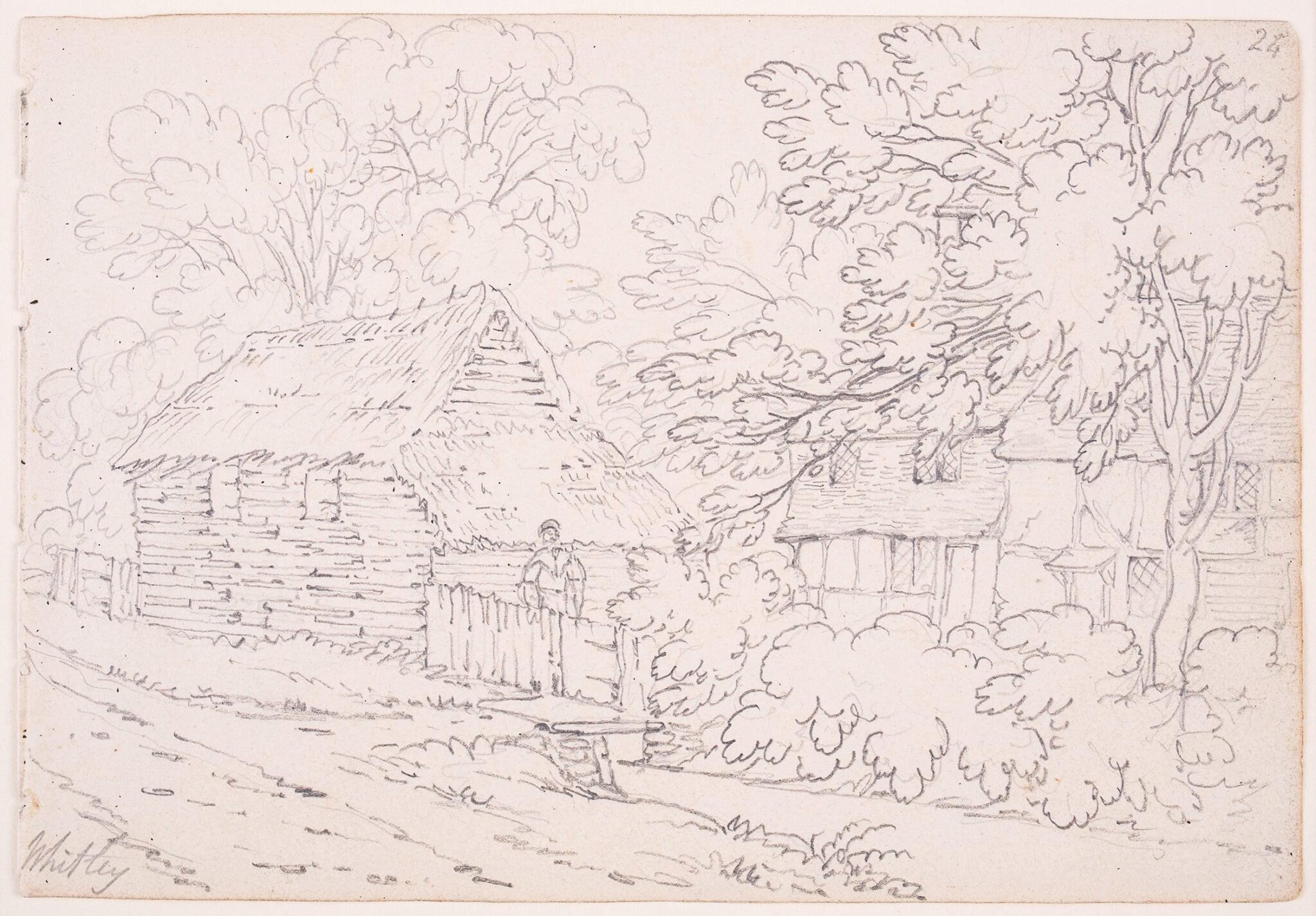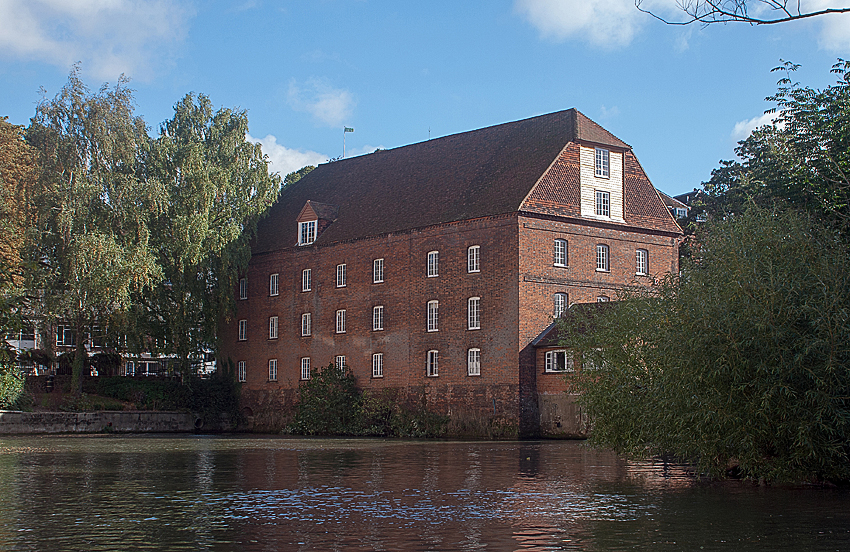|
River Ock, Surrey
The River Ock is a tributary of the River Wey in Surrey, England. Course The river has two great sources in the west of Hambledon, Surrey, Hambledon and two similar sources in the east of the parish of Witley. The coalescence is north of a zone of gently north-sloping land forming Wheelerstreet, Witley#Enton, Enton Green and the little manor of Tuesley. For centuries the latter comprised a very modest house and farmstead, dwarfed by the adjacent Busbridge Park, the stream of which drains Busbridge#Busbridge Lakes, Busbridge Lakes, the former mid and lower fish ponds, the upper one having been drained on becoming part of that stream. The resulting Ock passes through Ockford, sometimes considered the east of Ockford Ridge, parts of Godalming, before flowing into the Wey in the town centre. The Portsmouth Main Line railway follows much of the course. Watermills The Old Mill in Godalming, originally known as Hatch Mill, made use of the force and speed of the multi-hill-draining ... [...More Info...] [...Related Items...] OR: [Wikipedia] [Google] [Baidu] |
England
England is a country that is part of the United Kingdom. It shares land borders with Wales to its west and Scotland to its north. The Irish Sea lies northwest and the Celtic Sea to the southwest. It is separated from continental Europe by the North Sea to the east and the English Channel to the south. The country covers five-eighths of the island of Great Britain, which lies in the North Atlantic, and includes over 100 smaller islands, such as the Isles of Scilly and the Isle of Wight. The area now called England was first inhabited by modern humans during the Upper Paleolithic period, but takes its name from the Angles, a Germanic tribe deriving its name from the Anglia peninsula, who settled during the 5th and 6th centuries. England became a unified state in the 10th century and has had a significant cultural and legal impact on the wider world since the Age of Discovery, which began during the 15th century. The English language, the Anglican Church, and Engli ... [...More Info...] [...Related Items...] OR: [Wikipedia] [Google] [Baidu] |
Wheelerstreet
Witley is a village and civil parish in the Borough of Waverley in Surrey, England centred south west of the town of Godalming and southwest of Guildford. The land is a mixture of rural (ranging from woodland protected by the Surrey Hills AONB including a small part of the forested Greensand Ridge to cultivated fields) contrasting with elements more closely resembling a suburban satellite village. As a civil parish it is unusual in that it includes the small town of Milford in the north. Occupying its hills in the south-west are Sandhills and Brook. Witley Common is a wide expanse of land, owned by the National Trust, crossed by the A3 road. The village is served by two stations on the Portsmouth Direct Line: Witley station, to the south in nearby Wormley, and, to the north, Milford station, which is more or less equidistant between Milford and Witley. Its church dates to the pre-Norman Conquest period of the Kingdom of England. The village has the private sect ... [...More Info...] [...Related Items...] OR: [Wikipedia] [Google] [Baidu] |
Mills On The River Wey And Its Tributaries
Many watermills lined the banks of the River Wey, England, from the 17th century due to the river's ability to provide a reliable, year-round flow of water. These mills chiefly ground wheat, often referred to as corn, for flour and oats for animal feed though many were used in the production of other goods such as paper, cloth, leather, wire and gunpowder. The river was home to more mills per mile than anywhere else in Great Britain. The mill situated at Coxes Lock near Addlestone, Surrey, is the largest. There are many mills on the river's principal tributaries, such as the Tillingbourne, the Ock and some mills on the Whitmore Vale stream, Cranleigh Waters and Hodge Brook. The last commercial mill on the Tillingbourne, Botting's Mill at Albury, closed in 1991. Headley Water Mill, on the Wey South branch is still in business. Town Mill, Guildford still has a water turbine driven generator producing electricity for the town. Note: The mills are listed from source to mouth for ea ... [...More Info...] [...Related Items...] OR: [Wikipedia] [Google] [Baidu] |
Angiosperm
Flowering plants are plants that bear flowers and fruits, and form the clade Angiospermae (), commonly called angiosperms. The term "angiosperm" is derived from the Greek words ('container, vessel') and ('seed'), and refers to those plants that produce their seeds enclosed within a fruit. They are by far the most diverse group of land plants with 64 orders, 416 families, approximately 13,000 known genera and 300,000 known species. Angiosperms were formerly called Magnoliophyta (). Like gymnosperms, angiosperms are seed-producing plants. They are distinguished from gymnosperms by characteristics including flowers, endosperm within their seeds, and the production of fruits that contain the seeds. The ancestors of flowering plants diverged from the common ancestor of all living gymnosperms before the end of the Carboniferous, over 300 million years ago. The closest fossil relatives of flowering plants are uncertain and contentious. The earliest angiosperm fossils are in the ... [...More Info...] [...Related Items...] OR: [Wikipedia] [Google] [Baidu] |
Invertebrate
Invertebrates are a paraphyletic group of animals that neither possess nor develop a vertebral column (commonly known as a ''backbone'' or ''spine''), derived from the notochord. This is a grouping including all animals apart from the chordate subphylum Vertebrata. Familiar examples of invertebrates include arthropods, mollusks, annelids, echinoderms and cnidarians. The majority of animal species are invertebrates; one estimate puts the figure at 97%. Many invertebrate taxa have a greater number and variety of species than the entire subphylum of Vertebrata. Invertebrates vary widely in size, from 50 μm (0.002 in) rotifers to the 9–10 m (30–33 ft) colossal squid. Some so-called invertebrates, such as the Tunicata and Cephalochordata, are more closely related to vertebrates than to other invertebrates. This makes the invertebrates paraphyletic, so the term has little meaning in taxonomy. Etymology The word "invertebrate" comes from the Latin word ''vertebra'', whi ... [...More Info...] [...Related Items...] OR: [Wikipedia] [Google] [Baidu] |
Neville Bulwer-Lytton, 3rd Earl Of Lytton
Neville Stephen Bulwer-Lytton, 3rd Earl of Lytton, OBE (6 February 1879 – 9 February 1951) was a British military officer, Olympian and artist. Early life Neville Lytton was born in British India on 6 February 1879 while his parents served as viceroy and vicereine: Robert Bulwer-Lytton, 1st Earl of Lytton and Edith Villiers. Neville was the grandson of the famous novelists, Edward Bulwer-Lytton and Rosina Doyle Wheeler. His siblings included the suffragette Constance Lytton, Betty Balfour, Countess of Balfour (and sister in law of the prime minister), and Emily Lutyens, wife of the architect Edwin Lutyens. A keen amateur cricketer, he played minor counties cricket for Hertfordshire from 1896 to 1898, making five appearances. He was educated at Eton College and at the École des Beaux-Arts in Paris. He competed in the 1908 Summer Olympics and won the bronze medal in the real tennis competition. Career During World War I, Neville Lytton served as an officer on the We ... [...More Info...] [...Related Items...] OR: [Wikipedia] [Google] [Baidu] |
Busbridge
Busbridge is a village and civil parish in the borough of Waverley in Surrey, England that adjoins the town of Godalming. It forms part of the Waverley ward of '' Bramley, Busbridge and Hascombe''. It was until the Tudor period often recorded as Bushbridge and was a manor and hamlet of Godalming until gaining an ecclesiastical parish in 1865 complemented by a secular, civil parish in 1933. Gertrude Jekyll lived at Munstead Wood in the Munstead Heath locality of the village. Philip Carteret Webb and Chauncy Hare Townshend, the government lawyer/antiquarian and poet respectively owned its main estate, Busbridge House, the Busbridge Lakes element of which is a private landscape garden and woodland that hosts a wide range of waterfowl. The parish covers northern, heavily wooded foothills of the Greensand Ridge and drains separately to east and west into tributaries of the Wey. History Busbridge was wholly in the Anglo-Saxon hundred of Godalming, Surrey but had at the Domesda ... [...More Info...] [...Related Items...] OR: [Wikipedia] [Google] [Baidu] |
Tuesley
Busbridge is a village and civil parish in the borough of Waverley in Surrey, England that adjoins the town of Godalming. It forms part of the Waverley ward of '' Bramley, Busbridge and Hascombe''. It was until the Tudor period often recorded as Bushbridge and was a manor and hamlet of Godalming until gaining an ecclesiastical parish in 1865 complemented by a secular, civil parish in 1933. Gertrude Jekyll lived at Munstead Wood in the Munstead Heath locality of the village. Philip Carteret Webb and Chauncy Hare Townshend, the government lawyer/antiquarian and poet respectively owned its main estate, Busbridge House, the Busbridge Lakes element of which is a private landscape garden and woodland that hosts a wide range of waterfowl. The parish covers northern, heavily wooded foothills of the Greensand Ridge and drains separately to east and west into tributaries of the Wey. History Busbridge was wholly in the Anglo-Saxon hundred of Godalming, Surrey but had at the Dome ... [...More Info...] [...Related Items...] OR: [Wikipedia] [Google] [Baidu] |
Witley
Witley is a village and civil parish in the Borough of Waverley in Surrey, England centred south west of the town of Godalming and southwest of Guildford. The land is a mixture of rural (ranging from woodland protected by the Surrey Hills AONB including a small part of the forested Greensand Ridge to cultivated fields) contrasting with elements more closely resembling a suburban satellite village. As a civil parish it is unusual in that it includes the small town of Milford in the north. Occupying its hills in the south-west are Sandhills and Brook. Witley Common is a wide expanse of land, owned by the National Trust, crossed by the A3 road. The village is served by two stations on the Portsmouth Direct Line: Witley station, to the south in nearby Wormley, and, to the north, Milford station, which is more or less equidistant between Milford and Witley. Its church dates to the pre-Norman Conquest period of the Kingdom of England. The village has the private sector, bu ... [...More Info...] [...Related Items...] OR: [Wikipedia] [Google] [Baidu] |
Surrey
Surrey () is a ceremonial and non-metropolitan county in South East England, bordering Greater London to the south west. Surrey has a large rural area, and several significant urban areas which form part of the Greater London Built-up Area. With a population of approximately 1.2 million people, Surrey is the 12th-most populous county in England. The most populated town in Surrey is Woking, followed by Guildford. The county is divided into eleven districts with borough status. Between 1893 and 2020, Surrey County Council was headquartered at County Hall, Kingston-upon-Thames (now part of Greater London) but is now based at Woodhatch Place, Reigate. In the 20th century several alterations were made to Surrey's borders, with territory ceded to Greater London upon its creation and some gained from the abolition of Middlesex. Surrey is bordered by Greater London to the north east, Kent to the east, Berkshire to the north west, West Sussex to the south, East Sussex to ... [...More Info...] [...Related Items...] OR: [Wikipedia] [Google] [Baidu] |




